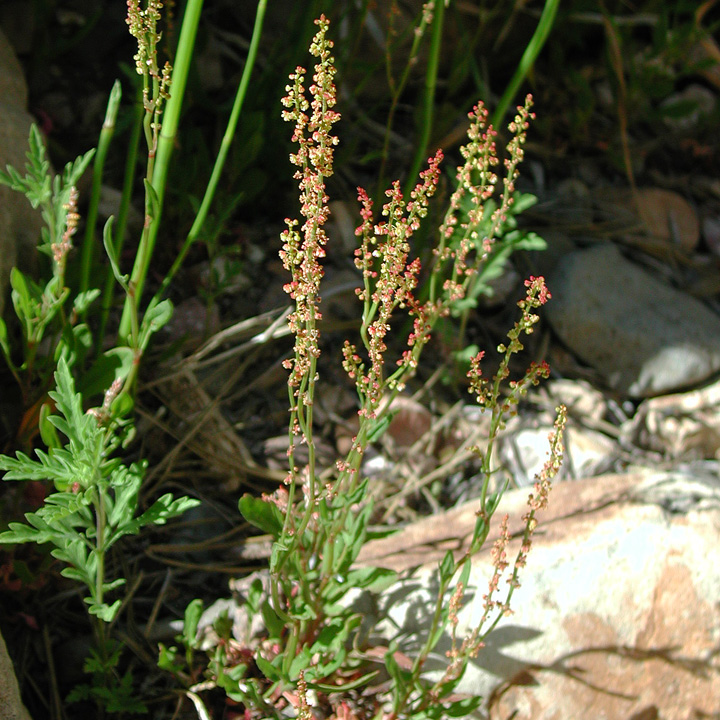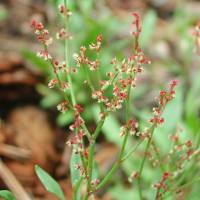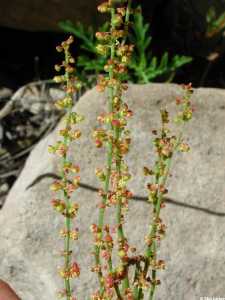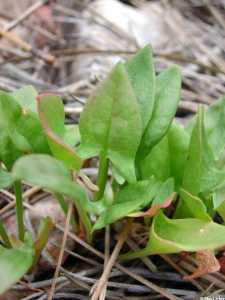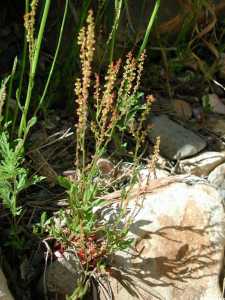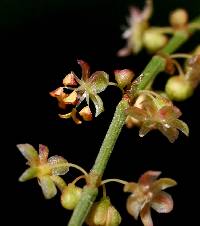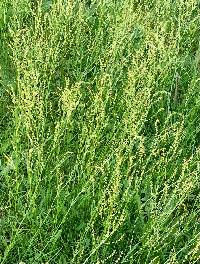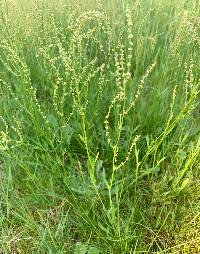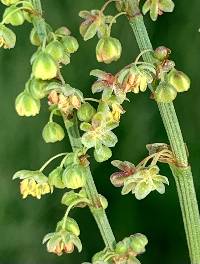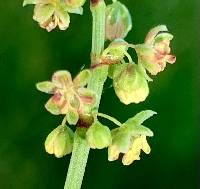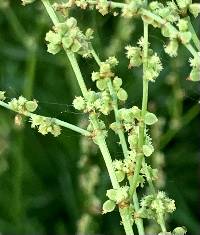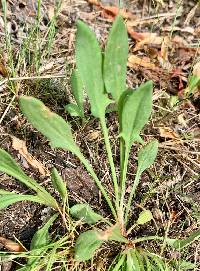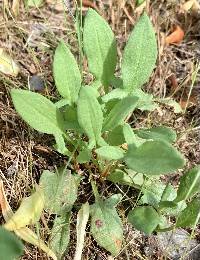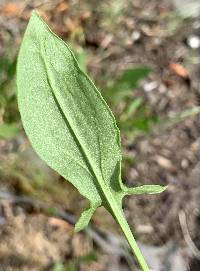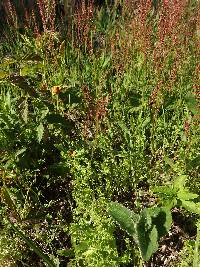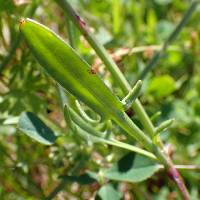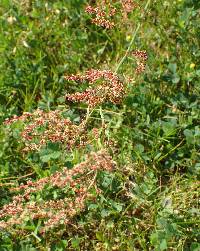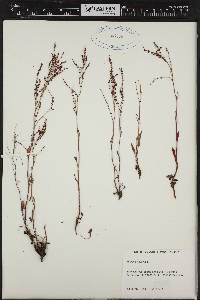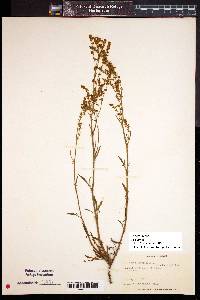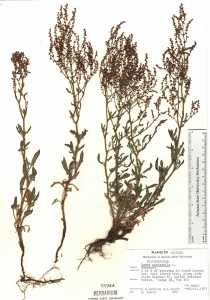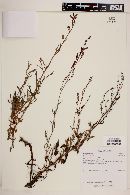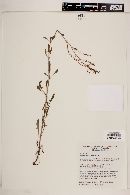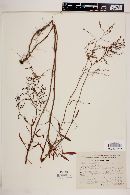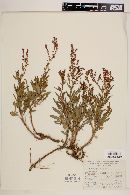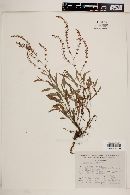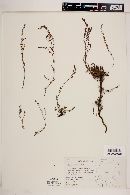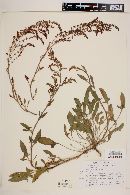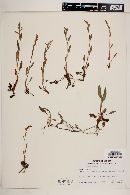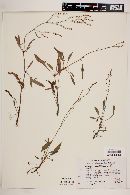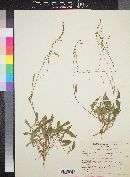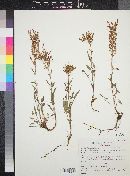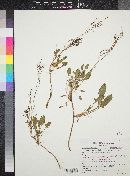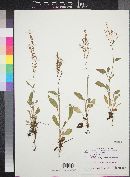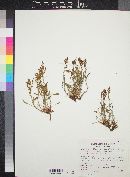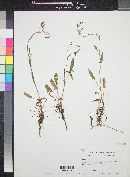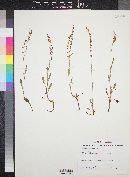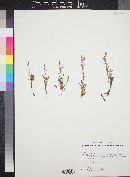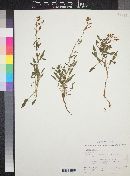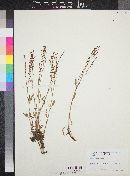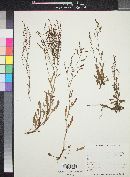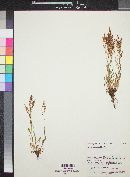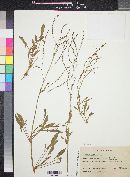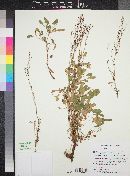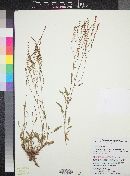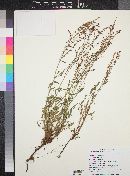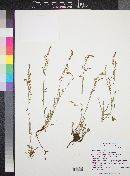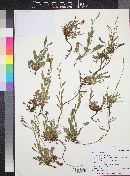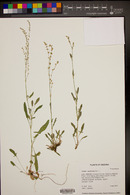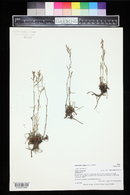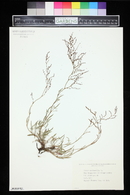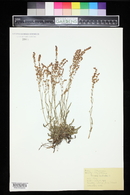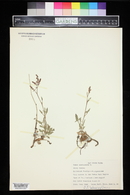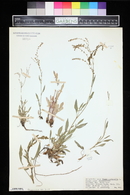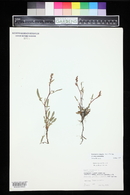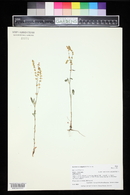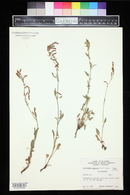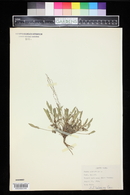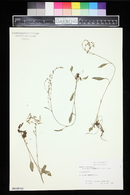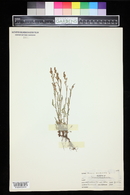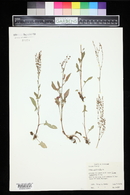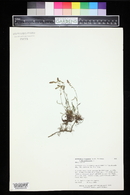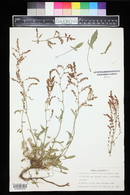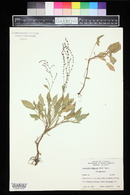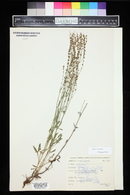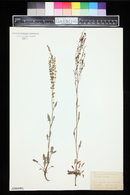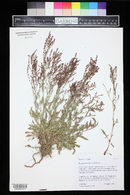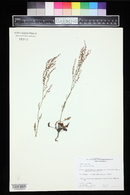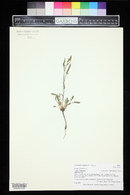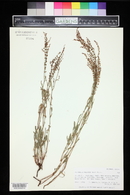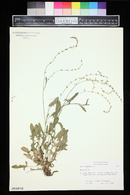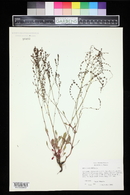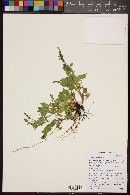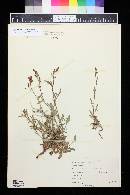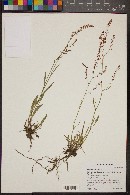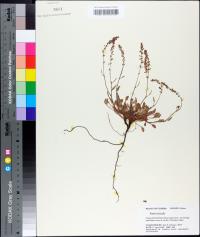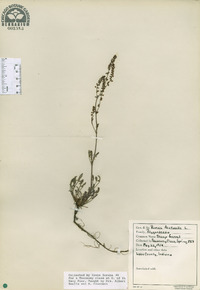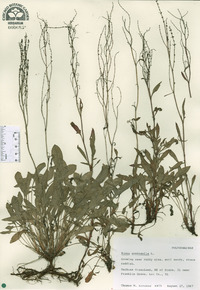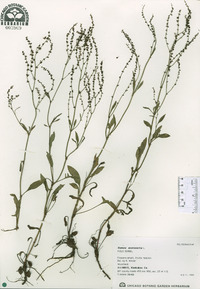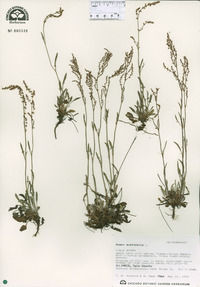Rumex acetosella
|
|
|
|
Family: Polygonaceae
Common Sheep Sorrel, more...sheep sorrel, field sorrel, red (or sheep) sorrel, red sorrel
[Acetosa acetosella (Linnaeus) P. Miller, moreAcetosella acetosella (L.) Small, Acetosella tenuifolia (Wallr.) A. Löve, Acetosella vulgaris (Koch) Fourr., Rumex acetosella subsp. angiocarpus (Murb.) Murb., Rumex acetosella var. pyrenaeus (Pourret) Timbal-Lagrave, Rumex acetosella var. tenuifolius Wallr., Rumex angiocarpus Murb., Rumex tenuifolius (Wallr.) A. Löve] |
Kearney and Peebles 1969, McDougall 1973 Duration: Perennial Nativity: Non-Native Lifeform: Forb/Herb General: Herbaceous and rhizomatous perennial, erect, simple or branching, stems grooved, glabrous, to 60 cm tall. Leaves: Hastate to entire, alternate, the stipules united into a cylindric sheath, 2-8 cm long. Flowers: Unisexual, the perianth green or purple, 6-parted, borne in narrow, open panicles, becoming large and modified in fruit and reddish with age. Fruits: Achenes 1-2 mm long. Ecology: Found often in disturbed habitats but generally adventive from 5,500-8,500 ft (1676-2519 m); flowering May-August. Notes: The keys to this species are the hastately lobed leaves (arrowhead shaped) and the dioecious flowers (both sexes on the same plant). Ethnobotany: Used for warts and bruises and sores, chewed for stomachaches, for tuberculosis, and generally used for food as greens. Etymology: Rumex is the Latin name for docks or sorrels, while acetosella is a pre-Linnaean name for common sorrel. Synonyms: Many, see Tropicos Editor: LCrumbacher, 2011 Plants perennial, glabrous, with vertical rootstock and/or creeping rhizomes. Stems erect or ascend-ing, several from base, branched in distal 1/ 2 (in inflorescence), 10-40(-45) cm; shoots variable. Leaves: ocrea brownish at base, silvery and lacerated in distal 1/ 2; blade normally obovate-oblong, ovate-lanceolate, lanceolate-elliptic, or lanceolate, occasionally, linear-lanceolate to almost linear, 2-6 × 0.3-2 cm, base hastate (with spreading, entire or sometimes multifid, dissected lobes), occasionally without evident lobes, then base broadly cuneate, margins entire, flat or nearly so, apex acute or obtuse. Inflorescences terminal, usually occupying distal 2- 3 of stem, usually lax and interrupted to top, broadly or narrowly paniculate. Pedicels 1-3 mm. Flowers (3-)5-8(-10) in whorls; inner tepals not or slightly enlarged, normally 1.2-1.7(-2) × 0.5-1.3 mm (free wing absent or barely visible), base cuneate, apex obtuse or subacute. Achenes brown or dark brown, 0.9-1.5 × 0.6-0.9 mm. 2n = 14, 28, 42. Flowering spring-summer. Roadsides, cultivated fields, waste places, disturbed areas, lawns, meadows, railroad gravels, sandy and muddy shores: usually in acidic soils; 0-2700 m; introduced; Greenland; St. Pierre and Miquelon; Alta., B.C., Man., N.B., Nfld. and Labr. (Nfld.), N.S., Ont., P.E.I., Que., Sask., Yukon; Ala., Alaska, Ariz., Ark., Calif., Colo., Conn., Del., D.C., Fla., Ga., Idaho, Ill., Ind., Iowa, Kans., Ky., La., Maine, Md., Mass., Mich., Minn., Miss., Mo., Mont., Nebr., Nev., N.H., N.J., N.Mex., N.Y., N.C., N.Dak., Ohio, Okla., Oreg., Pa., R.I., S.C., S.Dak., Tenn., Tex., Utah, Vt., Va., Wash., W.Va., Wis., Wyo.; Europe; w Asia; introduced almost worldwide. Rumex acetosella in the broad sense is an extremely variable and taxonomically complicated polyploid complex, which includes diploids, tetraploids, hexaploids, and octoploids. This complex (excluding more distantly related arctic-montane R. graminifolius and its allies) probably originated and developed mostly in southern Europe and southwestern Asia. Some races of R. acetosella now are distributed almost worldwide as introduced and often completely naturalized aliens. Á. Löve (1941, 1983) assumed that in this group chromosome numbers are strictly correlated with morphology. In his opinion, every chromosome race represents a distinct species: diploid Rumex angiocarpus Murbeck [= Acetosella angiocarpa (Murbeck) Á. Löve]; tetraploid R. multifidus Linnaeus [= R. tenuifolius (Wallroth) Á. Löve = Acetosella multifida (Linnaeus) Á. Löve]; hexaploid R. acetosella in the narrow sense [= A. vulgaris (W. D. J. Koch) Fourreau, with gymnocarpous A. vulgaris subsp. vulgaris and angiocarpous A. vulgaris subsp. pyrenaica (Pourret ex Lapeyrouse) Á. Löve]; hexaploid R. graminifolius Rudolph ex Lambert [= A. graminifolia (Rudolph ex Lambert) Á. Löve]. However, the distribution given by Löve for these taxa seems unnatural. Studies by J. C. M. den Nijs and collaborators (den Nijs 1974, 1976, 1984; den Nijs and T. Panhorst 1980; den Nijs et al. 1980, 1985; see also W. Harris 1969, 1973) indicate that the situation is more complicated. They postulated the development of two major evolutionary lines into two ploidy complexes: a primary western Mediterranean one and a secondary eastern Mediterranean one. According to this scheme, polyploid races independently and spontaneously emerged (and still are emerging) within different ancestral populations. The most widespread, almost cosmopolitan race, presumably native to the southwestern Mediterranean region, including southwestern and Atlantic Europe, which is common in North America, is characterized by a hexaploid chromosome set (2n = 42), nonmultifid lateral lobes of basal leaves, and angiocarpy (fruits are not easily separable from accrescent inner tepals). It was commonly and erroneously referred to as Rumex angiocarpus Murbeck, or R. acetosella subsp. angiocarpus (Murbeck) Murbeck. According to J. R. Akeroyd (1991), who in general followed the taxonomic revision of the group by J. C. M. den Nijs (1984), the correct name for this taxon is R. acetosella subsp. pyrenaicus (Pourret ex Lapeyrouse) Akeroyd (=Acetosella vulgaris subsp. pyrenaica (Pourret ex Lapeyrouse) Á. Löve). Gymnocarpous nonmultifid and multifid forms (R. acetosella subsp. acetosella and R. acetosella subsp. acetoselloides (Balansa) den Nijs, respectively) also occur in North America, but evidently rarely. The distributions of subspecies of R. ace Dioecious perennial 1-4 dm from slender creeping roots; lvs variable, usually 3-lobed, the terminal lobe narrowly elliptic to oblong, the lateral much smaller, triangular, divergent; lf-base below the lobes truncate to long-cuneate; infl sometimes half the length of the shoot; pedicel jointed next to the fl; outer tep lanceolate; inner tep in male fls 1.5-2 mm, obovate, in female broadly ovate; achene 1.5 mm, shiny golden brown, closely invested by the valves; 2n=14, 28, 42. Fields, lawns, and waste places, in acid soils; native of Eurasia, naturalized throughout most of N. Amer., and highly variable. Gleason, Henry A. & Cronquist, Arthur J. 1991. Manual of vascular plants of northeastern United States and adjacent Canada. lxxv + 910 pp. ©The New York Botanical Garden. All rights reserved. Used by permission. From Flora of Indiana (1940) by Charles C. Deam An abundant weed in some cultivated fields. Its presence is usually indicative of impoverished and minimacid soils. In the sandy areas of the northwestern part of the state it is an obnoxious weed, covering sometimes whole fields. It is somewhat frequent in the entire northern part of the state, rare in the central, and frequent in the southern part. …… Indiana Coefficient of Conservatism: C = null, non-native Wetland Indicator Status: FACU |
|
|
|

